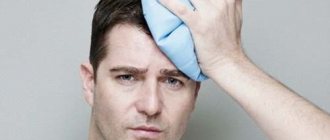Spinal osteochondrosis is a degenerative-dystrophic process that results in damage to the cartilaginous segments of the spine (intervertebral discs) with subsequent involvement of other parts of the spinal segment in the process. Due to greater mobility in the cervical region compared to other parts of the spine and a weak muscular frame, cervical osteochondrosis is observed very often - in more than 25% of cases. AND headache – one of the most common manifestations of this disease.
Clinical picture of cervical osteochondrosis
The degree of severity and nature of symptoms in cervical osteochondrosis depends on the stage of the degenerative-dystrophic process, as well as on the location of the lesion. It should be noted that there is no specific clinic for cervical osteochondrosis; the main manifestations of the disease are pain and loss of sensitivity in the neck, back of the head, shoulder girdle, arms and fingers.
Cervical osteochondrosis is almost always accompanied by headaches (cephalgia), cervicalgia (pain in the neck, radiating to the back of the head, shoulder and arms), limited mobility of the upper spine (neck and shoulder girdle), and dizziness.
Depending on the damage to a particular spinal segment, headaches may be observed in different localizations, combined with numbness, short-term or long-term loss of sensation in the shoulder and arms, down to the fingers.
External causes of ear pain
The main factors that may cause discomfort or pain in the ear are:
- Injury, blows, frostbite or burns - cartilage and even the external auditory canal can be damaged and can cause ear pain
- Changes in atmospheric pressure (during diving or air travel)
- Prolonged pressure (for example, from tight or uncomfortable headphones).
- Getting a foreign body into the ear, accumulation of wax plugs in it, careless cleaning of the ears is the cause of pain in the ear on one side.
- Contact with water when swimming or bathing.
- Loud noise – from music, working in noisy rooms.
Why is cervical osteochondrosis accompanied by headaches and dizziness?
Headaches are a very common complaint with cervical osteochondrosis. It is often accompanied by symptoms such as dizziness, poor coordination, and blurred vision. Let's consider how changes in the spinal column during cervical osteochondrosis lead to similar symptoms.
In the transverse processes from the VI to II cervical vertebrae there are canals through which the vertebral arteries pass, supplying blood to many parts of the brain and the so-called “Frank’s nerve”. Due to degenerative changes in the joints of the spine and directly in the vertebrae, the formation of osteophytes (bone growths) occurs, which leads to a narrowing of the spinal canal and compression of elements of the neurovascular system.
Osteophytes directed to the muscles irritate them, this causes a reflex muscle spasm, which leads to compression of the intervertebral discs, aggravating the course of the disease. Osteophytes, irritating the nerve roots at the exit of the spinal column, cause pain and spasms, the localization of which depends on the affected area.
Osteophytes directed to the canal of the transverse processes irritate Frank's sympathetic nerve, which leads to spasm of the vertebral artery, and also mechanically compress this artery, provoking a violation of cerebral circulation.
An acute disturbance of cerebral hemodynamics (brain circulation) leads to the development of an ischemic attack of the brain, which leads to the appearance of symptoms of cervical osteochondrosis such as dizziness, nausea, headache, loss of coordination, and blurred vision.
Another reason for compression of the Frank nerve and the vertebral artery is displacement of the disc in the posterolateral and lateral directions, protrusion of the disc into the intervertebral canal during a hernia or protrusion (protrusion of the disc without violating its integrity).
The cause of compression of the nervous and vascular structures in the cervical spine can also be subluxation of the cervical vertebrae, their confusion relative to their natural position.
In addition, muscle spasm caused by psycho-emotional fatigue, excessive physical exertion or an uncomfortable position during sleep also leads to poor circulation in the cervical region and, as a consequence, headaches and dizziness.
How to treat ear pain
Treatment depends on the disease. So, cerumen plug is removed by washing with a special solution immediately at the doctor’s appointment, and to treat otitis media you will need antibacterial and anti-inflammatory drugs. It is important not only to relieve pain, but also to act on its cause. For this purpose, medications are used (tablets and local applications), physiotherapy (UHF, electrophoresis and others). Self-medication is dangerous due to complications - rupture of the eardrum, spread of infection to other organs, partial or complete loss of hearing.
If you can’t see a doctor immediately (for example, severe pain in the ear occurred in the evening), you can:
- Take painkillers.
- Make a compress - insert a cotton swab into the auricle (not deep) (it can be soaked in boric or camping alcohol).
- Place drops in the nose, because ear pain often occurs from diseases and swelling in the nasopharynx
You can’t do it yourself:
- Warm up the ears - in case of infections, this can lead to even greater inflammation.
- Use ear drops and ear suppositories from your home medicine cabinet - they may not be suitable for this diagnosis, and open ear drops cannot be stored for a long time.
- Trying to wash out the plug or remove a stuck foreign body can damage the eardrum.
Be sure to consult with an ENT doctor if your ear is bothering you or you notice a rash, itching, discharge from the ear canal, auditory distortion or deterioration in hearing acuity. We invite you to the Kutuzovsky Children's Center - a clinic where experienced and knowledgeable doctors work. Our otolaryngologists (and other specialists) are available to see you daily by appointment. The clinic has all the necessary equipment to carry out the necessary diagnostic and therapeutic procedures; also in our center you can undergo a body check up - a full medical examination at an affordable cost. Don’t tolerate pain – it can really be cured!
Prices
| Name | Price |
| Primary appointment (examination, consultation) with an otorhinolaryngologist | 2 200 ₽ |
| Repeated appointment (examination, consultation) with an otorhinolaryngologist | 1 900 ₽ |
Features of headaches in cervical osteochondrosis.
Headaches (cephalgia) with cervical osteochondrosis are usually of moderate intensity. Patients characterize the pain as dull, pulling, boring, pressing (feeling of squeezing of the head). Cephalgia with osteochondrosis is usually paroxysmal in nature (from several hours to several days).
Most often, the pain is one-sided, localized in the cervical-occipital region and spreads to the frontal and temporal regions.
Headaches with cervical osteochondrosis are often accompanied by:
- photophobia (intolerance to bright light);
- phonophobia (increased sensitivity to sounds, noise);
- feeling of stuffiness in the ear;
- complaints of blurred vision.
Stiffness in the cervical spine and muscle tension are often noted. Pain and stiffness depend on the position of the neck, and intensify with tension in the muscles of the affected side, or with prolonged stay in an uncomfortable position.
Headaches with cervical osteochondrosis are often combined with pain in the shoulder and arm.
First symptoms of spasm
Before a migraine attack, the patient experiences:
- Nausea, vomiting.
- State of chill.
- increases .
- Starts to flash before your eyes.
- is distorted .
- Irritable reaction to loud noises and bright lights.
Meteor dependence:
- Drowsiness, weakness.
- Changes in blood pressure.
Tumor:
- Nausea, vomiting.
- Loss of coordination.
- Visual and hearing disorders
- Deterioration of sleep and appetite.
Stroke:
- Why does it hurt behind the ear on the right and left, how to relieve the pain?
- Fainting.
- Blurred consciousness.
- Loss of coordination.
- Speech and disorders .
- Nausea, vomiting.
The listed symptoms can also be observed in other diseases; in addition, dizziness, congestion or noise in the ears, and clouding in the eye area may occur before the attack. You should pay more attention to any changes in the body.
What can provoke increased headaches with cervical osteochondrosis
- Prolonged forced positioning of the body, especially while sitting at a computer or desk.
- Uncomfortable head position during sleep;
- Sudden head movements, especially rotational ones.
- Impacts, injuries.
- Incorrectly performed massage and other manual procedures.
- Excess weight puts more stress on the spine.
- Eating spicy and salty foods does not directly worsen the headache, but leads to disruption of metabolic processes, which aggravates the disease.
Treatment
Analgesics are one of the effective means of combating headaches. However, we should not forget that they do not eliminate the main cause that caused such a reaction, but only eliminate the clinical manifestations, and after some time the pain will remind itself again.
Make an appointment through the application or by calling +7 +7 We work every day:
- Monday—Friday: 8.00—20.00
- Saturday: 8.00–18.00
- Sunday is a day off
The nearest metro and MCC stations to the clinic:
- Highway of Enthusiasts or Perovo
- Partisan
- Enthusiast Highway
Driving directions
How to get rid of headaches with cervical osteochondrosis
To relieve headaches, including those with cervical osteochondrosis, analgesics in combination with antispasmodics help well. For severe muscle tension and irritation, nonsteroidal anti-inflammatory drugs (NSAIDs) can be used. However, it must be remembered that these drugs do not treat the underlying disease, providing only symptomatic care, and at the same time they have a number of serious side effects. Thus, analgesics and NSAIDs, including those containing diclofenac, suppress bone marrow function, lower immunity, inhibit gastric secretion, irritating its mucous membrane and provoking the development of gastritis, and reduce blood clotting. In addition, it has been proven that systematic or frequent use of diclofenac increases the risk of heart attack by 40%, and NSAIDs in general lead to the formation of gastropathy, gum ulceration, pancreatitis and aphthous stomatitis. Antispasmodics can cause the opposite effect - increase dizziness, headache, and also cause palpitations and more complex arrhythmias.
Recently, Botox injections have been used to relieve spasms. However, botuloxin is a strong poison; in addition to the unpredictable individual reaction of the body, it can cause headaches, muscle weakness up to paresis of some muscle groups, disruption of the gastrointestinal tract and respiratory system. With each repeated use, the effect of the drug decreases.
Neuroprotectors have a prolonged (long-lasting) effect, improving metabolism in brain tissue and thereby relieving pain. However, such drugs must be taken in long courses, but if used uncontrolled, they can cause dizziness, headaches, anxiety, increased blood pressure and arrhythmia.
It is important to remember that in this case, a headache is only a symptom of the disease. In addition to symptomatic care, it is necessary to direct efforts to fight the disease itself - the spine needs to be treated.
Conservative treatment of osteochondrosis, in addition to the use of painkillers and antispasmodics, should include the use of hydroprotectors, vitamin complexes, as well as exercise therapy and physiotherapy.
Electrophoresis is the most commonly used physiotherapy procedure. Its essence is a local increase in temperature and improvement of blood circulation, which relieves muscle spasms, eliminates pain and speeds up the healing process. In general, any thermal procedures relieve muscle spasms and improve blood circulation.
Magnetotherapy involves the use of low-frequency magnetic field inductors aimed at the problem area, which leads to local dilation of blood vessels, improved oxygenation and metabolism, accelerated elimination of toxins and reduced blood viscosity. Thanks to this, magnetic therapy has an anti-inflammatory, analgesic and anti-edematous effect.
Effective assistance in the treatment of osteochondrosis of the cervical spine can be provided by a modern drug - the therapeutic pain-relieving anti-inflammatory patch NANOPLAST forte.
Causes and possible diseases
Pain in the head on the left side above the ear is a symptom of a number of diseases!
Headache is a problem for all people. The thing is that if your hand hurts, then it’s a hand disease, but if you have a headache, it can indicate any disease in the body. If pain occurs above the ear on the left, this may indicate various pathologies. Different types of pain may indicate different causes.
- Why does the jaw hurt on one side when chewing near the ear: what does pain on the right and left mean, how to treat it?
Let's look at the main causes and diseases that can cause headaches on the left side:
- Otitis is an inflammatory process of the ear, which can occur as a complication after an infectious disease or as an independent pathology arising due to the development of pathogenic microorganisms. In this case, severe pain occurs in the ears, radiating to the head above the ear. In addition, there are other symptoms - discharge from the ears, clicking sounds when swallowing, increased body temperature
- lymphadenitis (inflammation of the lymph nodes) is not an independent disease and occurs most often at the onset of an infectious disease
- Mumps (mumps) is an infectious pathology caused by paramyxovirus. The main symptom is inflammation of the salivary gland, which causes pain in the head above the ears. In this case, general weakness occurs and the temperature rises. This disease requires immediate treatment, as it has many complications (pancreatitis, meningitis, infertility)
- damage to osteochondral tissues and muscle mass. Most often, osteochondrosis impairs blood circulation, which impairs the supply to the cerebral cortex. This is what causes pain above the ears.
- sinusitis, rhinitis, tonsillitis, influenza - these diseases are localized in the upper respiratory tract. They affect the nasopharynx and throat. When the nerve endings are affected, the pain radiates to the head, and specifically to the ears and above.
- toothache, especially if the roots of the upper teeth are affected, pain may occur in the ears and above the ears
If there is prolonged pain in the head above the ear (2-3 days), you should consult a doctor to get examined. The doctor will prescribe a series of tests and will be able to formulate a course of treatment.
Treatment of cervical osteochondrosis with a therapeutic plaster NANOPLAST forte
When treating cervical osteochondrosis, the NANOPLAST forte therapeutic plaster allows you to relieve pain and inflammation, improve blood circulation in the affected area, and relieve muscle spasms. Depending on the condition and severity of degenerative changes in the spine, the drug can be used both in monotherapy and in complex treatment of osteochondrosis. The use of the NANOPLAST patch in complex treatment allows you to reduce the dose of painkillers and anti-inflammatory drugs, enhance their effect, and speed up recovery processes.
The patch combines two types of physiotherapeutic effects - deep soft heating and magnetotherapeutic properties. Long-term exposure - for 12 hours - provides a high therapeutic effect of the drug.
When treating cervical osteochondrosis, the therapeutic plaster NANOPLAST forte is applied to the disturbing area of the neck, avoiding the anterior surface, especially the area of the carotid arteries and lymph nodes. A course of treatment of 9 days or more is recommended. It is usually recommended to use the patch in the morning for 12 hours, but it can also be used at night.
High efficiency, unique composition, long-term (up to 12 hours!) therapeutic effects, ease of use and affordable price make NANOPLAST forte the drug of choice in the treatment of cervical osteochondrosis.
Read more about NANOPLAST forte










